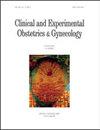Predicting Tumour Progression of ID-8 Syngeneic Mouse Ovarian Cancer with Blood Biomarkers of CA-125, IL-6 and VEGF: A Prospective Laboratory-Based Study
IF 0.6
4区 医学
Q4 OBSTETRICS & GYNECOLOGY
引用次数: 0
Abstract
Background: A preclinical animal model is an imperative tool for uncovering and understanding the tumourigenic hallmarks of human ovarian cancer; the disease is often lethal because it is commonly diagnosed in the advanced stage, where widespread cancer nodules mainly reside within peritoneal regions. Mouse models as a xenograft tumour host or genetic manipulation ovarian cancer-derived mice are widely used for studying specific hypothesis rationale in ovarian cancer. However, limited information associated with disease progression is obtained from such studies; whether it is the best model to study advanced ovarian cancer phenotype or suitable preclinical biomarkers for detecting and monitoring ovarian cancer progression is under study. This study used an ID-8 syngeneic mouse ovarian cancer model with immunocompetence. We monitored cancer growth and development using combination modalities of cancer-specific cancer antigen-125 (CA-125), interleukin-6 (IL-6) and vascular endothelial growth factor (VEGF) blood markers, which are well-known for their association with tumour progression in humans. Methods: Ten C57/BL6 female mice were intraperitoneally implanted with ID-8 Trp53 wild-type and monitored the progression of the tumour, until mice developed clinical ascites. Blood was taken at the time of intraperitoneal (IP) implantation (Day 0) and then collected weekly, and levels of biomarkers were analysed with enzyme-linked immunosorbent assay (ELISA). In addition, tumour tissue was collected and proceeded with histological staining. Results: We found that blood biomarkers CA-125, IL-6 and VEGF were not readily correlated with tumour progression. However, these biomarkers were markedly elevated in ascitic fluid at the advanced stage of the disease. Conclusions: We conclude that blood biomarkers in a syngeneic mouse model are, to some extent, not readily found in the blood as opposed to human ovarian cancer. Model anatomical and physiological differences between rodents and humans might explain this discrepancy.用血液生物标志物CA-125、IL-6和VEGF预测ID-8同基因小鼠卵巢癌的肿瘤进展:一项前瞻性实验室研究
背景:临床前动物模型是揭示和理解人类卵巢癌致瘤特征的必要工具;这种疾病通常是致命的,因为它通常在晚期被诊断出来,此时广泛的癌症结节主要存在于腹膜区域。小鼠模型作为异种移植肿瘤宿主或基因操作卵巢癌衍生小鼠被广泛用于研究卵巢癌的特定假设原理。然而,从这些研究中获得的与疾病进展相关的信息有限;它是研究晚期卵巢癌表型的最佳模型,还是检测和监测卵巢癌进展的合适临床前生物标志物,目前还在研究中。本研究采用具有免疫能力的ID-8同基因小鼠卵巢癌模型。我们使用癌症特异性癌症抗原-125 (CA-125)、白细胞介素-6 (IL-6)和血管内皮生长因子(VEGF)血液标志物的联合模式监测癌症的生长和发展,这些血液标志物因与人类肿瘤进展相关而闻名。方法:10只C57/BL6雌性小鼠腹腔注射野生型ID-8 Trp53,监测肿瘤进展,直至小鼠出现临床腹水。在腹腔内(IP)植入时(第0天)采血,然后每周采集一次,用酶联免疫吸附试验(ELISA)分析生物标志物水平。此外,收集肿瘤组织并进行组织学染色。结果:我们发现血液生物标志物CA-125, IL-6和VEGF与肿瘤进展不容易相关。然而,在疾病的晚期,这些生物标志物在腹水中明显升高。结论:我们得出结论,同基因小鼠模型中的血液生物标志物在某种程度上不容易在血液中发现,而不是在人类卵巢癌中发现。啮齿类动物和人类在解剖学和生理学上的差异可以解释这种差异。
本文章由计算机程序翻译,如有差异,请以英文原文为准。
求助全文
约1分钟内获得全文
求助全文
来源期刊
CiteScore
0.50
自引率
0.00%
发文量
241
审稿时长
1 months
期刊介绍:
CEOG is an international, peer-reviewed, open access journal. CEOG covers all aspects of Obstetrics and Gynecology, including obstetrics, prenatal diagnosis, maternal-fetal medicine, perinatology, general gynecology, gynecologic oncology, uro-gynecology, reproductive medicine, infertility, reproductive endocrinology, sexual medicine. All submissions of cutting-edge advances of medical research in the area of women''s health worldwide are encouraged.

 求助内容:
求助内容: 应助结果提醒方式:
应助结果提醒方式:


